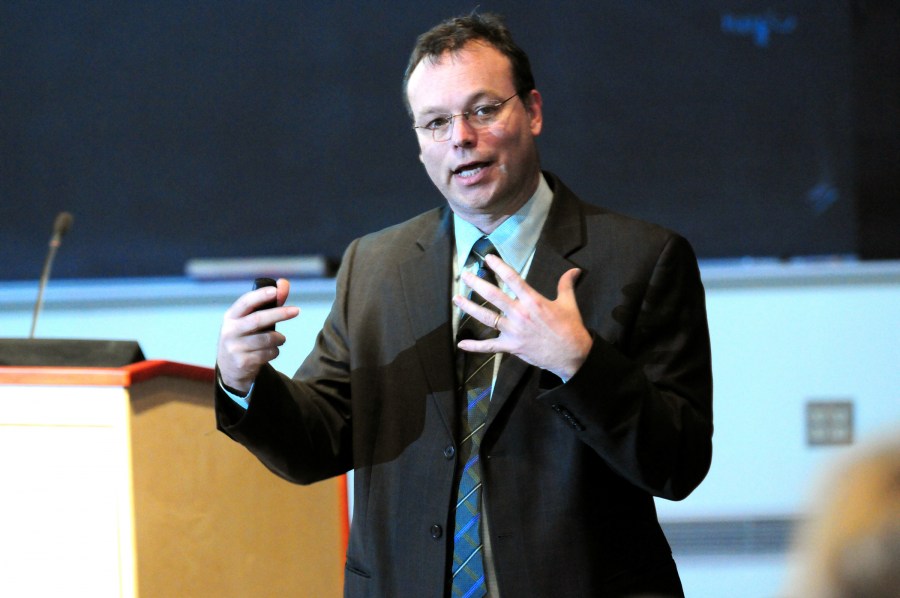
Jeff Balser, M.D., Ph.D., talks about VUMC’s preparations for health care reform during Tuesday’s Winter Faculty Meeting. (photo by Mary Donaldson)
VUMC prepared for shifting health care economy
Skyrocketing costs and a dangerously high national debt will soon force the U.S. health care system to become leaner, if not meaner.
While Vanderbilt University Medical Center cannot avoid the inevitable cuts to reimbursement on the horizon, it doesn't have to fall victim to them either, its top official said during Tuesday's Winter Faculty Meeting.
At a forum where Jeff Balser, M.D., Ph.D., vice chancellor for Health Affairs and dean of the School of Medicine, prioritizes academic programs, he felt compelled at this time to focus attention on the economic challenges the Medical Center and academic medicine as a whole will face.
“The health care economy in this country is changing radically,” Balser said. “The places that adapt and get out in front of the changes are the places that are going to succeed. Our economic sustainability and our goal to markedly advance the reputation of the Medical Center are interdependent.”
Doing this will require a series of steps, he said.
First, the Medical Center is already hard at work improving operational efficiencies, reducing expenditures and building its savings account. This process is in play, increasing productivity and efficiency, and more closely integrating systems, services and space.
“It's not that staff and faculty members aren't working hard enough. Everybody here works really hard,” he said.
Balser said this process is about learning how to work smarter to make best advantage of the Medical Center's organizational structure as an integrated health care system, and gain maximum performance from existing physical space.
For example, after some outpatient clinics were re-engineered to improve efficiency and productivity, the number of patients they can schedule increased by as much as 30 percent, yet staff found they had more time to get their work done.
The Vanderbilt Health Plan, which covers 20,000 employees and 40,000 family members, is undergoing similar transformation. Tighter control of the prescription medication formulary, along with greater management of high-cost medical conditions, will enable the self-insured plan to hold its annual 10 percent rise in per-enrollee costs to zero in the next fiscal year.
“The other real game changer for us is our ability to innovate,” Balser said.
Through MyHealthatVanderbilt.com, 130,000 patients view their medical records and talk with their physicians online, thereby reducing the number of clinic visits. A more recent innovation, MyHealthTeam at Vanderbilt, uses intensive case management to achieve remarkably improved control of high blood pressure, diabetes and other challenging chronic health conditions.
Fewer clinic visits and better control translate into significant savings.
These are examples of a “continuum of care” provided over time to individuals and populations based on their medical histories and risk factors. It's where health care is headed, Balser said, and it's “a much better way to take care of people anyway.”
Another innovation is the Diagnostic Management Team (DMT) established through Pathology last fall, to provide comprehensive decision support for ordering tests to manage patients with clotting disorders. By avoiding unnecessary coagulation testing and reducing hospital stays, the program will, within 12 months, save an estimated $250,000.
DMTs are yet another example of VUMC's leadership taking advantage of the latest basic science and clinical evidence, from VU and around the globe, and rapidly translating it into health care practice.
As diagnostic management teams begin to address other chronic illnesses and more commonly ordered tests are brought on line, millions of dollars in annual savings at Vanderbilt are anticipated. And when exported into the nation's academic medical centers and community hospitals, one could envision billions of dollars in annual savings.
Balser said the reputation of Medical Center faculty members, through these and many other efforts, is rising steadily. Gains in the number of highly-cited research papers, the frequency of nomination for national awards, and recognition through endowed chairs were highlighted.
As part of a University-wide initiative announced by Chancellor Nicholas S. Zeppos in the fall, an additional 30 endowed chairs will be awarded to School of Medicine faculty in the coming year, bringing the school into the top 10 in total endowed chairs among U.S. News and World Report's top 20 medical schools.
Vanderbilt will attract national attention as it thrives, leads and actually improves care in a dramatically different economic reality, while preparing the next generation of trainees for an entirely different way of working in the biomedical science and health care.
“If we proactively lead change, rather than react,” he said, “we can advance our reputation and at the same time build a sustainable economic model.”













